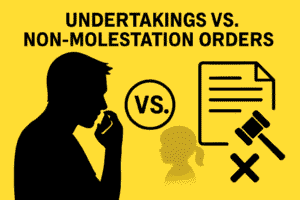When CAFCASS prepare a Section 7 report, their recommendations can shape the entire outcome of your case. Research shows judges follow CAFCASS recommendations in around 70–80% of cases – which means how you handle the interview, the evidence you provide, and your response to the final report can decide whether you succeed or struggle in family court.
🔑 Key Takeaways
- Judges follow CAFCASS Section 7 recommendations in around 70–80% of cases, so preparation is critical.
- The report is based on interviews, home visits, and checks with schools, GPs, and police.
- How you present yourself in the interview can shape the recommendations – stay calm, consistent, and child-focused.
- If the report feels unfair, the right way to respond is with a Position Statement, supported by evidence.
- Delays are common – reports usually take 12+ weeks – but the court won’t make final decisions until it’s complete.
Facing a Section 7 report can feel overwhelming — message us on WhatsApp for clear next steps.
Quick Navigation:
What Is a Section 7 Report?
A Section 7 report is ordered by the family court under the Children Act 1989. It asks CAFCASS (or sometimes social services) to investigate and advise on what arrangements are in the best interests of your child.
The officer will usually:
- Speak to both parents
- Speak to the child (depending on their age and understanding)
- Visit homes
- Contact schools, GPs, or other professionals
- Review case documents and safeguarding checks
The report ends with recommendations about contact, living arrangements, or other orders.
Want tailored prep before your CAFCASS interview? Reach out on WhatsApp and we’ll rehearse it with you.
How to Prepare for Your CAFCASS Interview
The interview is not a casual chat – it’s the foundation of the report. Dads often trip up here by being defensive, over-explaining, or attacking the other parent. Instead:
- Stay child-focused: Frame everything in terms of your child’s needs, not your conflict.
- Be consistent: Make sure what you say matches your application, statements, and evidence.
- Avoid blame language: If raising concerns about your ex, link them directly to impact on your child.
- Show stability: Talk through routines, support networks, and how you manage day-to-day parenting.
Common Pitfalls to Avoid
Many dads weaken their position without realising it. The biggest mistakes we see are:
- Lack of preparation – turning up without clear evidence or thought-out answers.
- Ineffective communication – sounding defensive, hostile, or vague.
- Ignoring the child’s wishes – dismissing what your child has said, instead of addressing it constructively.
- Overlooking documentation – relying only on spoken claims rather than school records, texts, or reports.
- Reacting emotionally to the report – responding in anger instead of filing a structured, factual reply.
Worried you might fall into these pitfalls? WhatsApp us now for a prep session that keeps you on track.
How to Respond to a Section 7 Report
When you receive the report, read it carefully. Even if it feels unfair, don’t panic. The key is to respond in writing before the next hearing:
- Identify inaccuracies: Highlight factual errors (dates, names, events) with supporting evidence.
- Challenge recommendations: Explain why a proposal isn’t in your child’s best interests, using welfare checklist factors.
- File a Position Statement: This is your official way to set out your response for the court.
- Stay calm: Judges want solutions and clarity, not more conflict.
👉 See our guide: How to Write a Family Court Position Statement
How Long Does a Section 7 Report Take?
A Section 7 report usually takes around 12 weeks to complete, though delays are common if fact-finding hearings or extra checks are ordered. The process generally looks like this:
- Weeks 1–2: The court orders the report and allocates a CAFCASS officer.
- Weeks 3–10: Interviews with parents, child (if appropriate), home visits, and checks with schools, GPs, and police.
- Weeks 11–12: The officer analyses the information, writes the report, and makes recommendations.
- Court filing: The report is shared with the court and both parents before the next hearing.
Some reports run over 16 weeks if extra safeguarding checks are needed – but judges can’t make final decisions until the report is filed.
Can You Challenge a Section 7 Report?
Yes. You can:
- Point out factual inaccuracies.
- File a detailed Position Statement.
- Ask the court to order the officer to attend the hearing for cross-examination.
- Provide counter-evidence that addresses welfare checklist factors.
Remember: complaints to CAFCASS won’t change recommendations. The place to challenge is inside court proceedings.
FAQs About Section 7 Reports
Dads usually have the same pressing questions about Section 7 reports – from what CAFCASS will ask, to how much weight the judge will give the recommendations. Here are straight answers to the most common ones, so you know what to expect and how to prepare.
What questions will CAFCASS ask in a Section 7 interview?
They may ask about your child’s routines, your relationship with them, your concerns about the other parent, and your proposals for the future.
How do I prepare for a CAFCASS home visit?
Make sure your home is safe, tidy, and child-friendly. Officers look for routines, stability, and how you interact with your child – not a show home.
Can CAFCASS speak to my child without me?
Yes. Depending on age, CAFCASS may see your child at school or in another setting to hear their wishes privately.
Do judges always follow Section 7 reports?
Not always – but they usually give them significant weight. If they disagree, they must explain why.
What if the Section 7 report feels biased?
Respond in court with clear, factual evidence and reference the welfare checklist. Professional support strengthens your challenge.
What’s the difference between a Section 7 and Section 37 report?
A Section 7 report is used in private law cases when the court needs advice on child arrangements between parents. A Section 37 report is different — it’s ordered if the court believes a child may be at risk of significant harm and asks the local authority to consider whether care proceedings are needed.
Do CAFCASS check social media during Section 7 assessments?
They can. Posts showing hostility, poor judgment, or conflict between parents may be referenced in safeguarding or Section 7 reports. It’s important to keep your online presence calm and child-focused while proceedings are ongoing.
How We Can Help
At Dads’ Consultancy, we know how much rides on a Section 7 report. Our support includes:
- Mock Section 7 Reports – so you know what to expect.
- Interview Preparation – tailored notes and practice Q&A.
- Strategic Responses – drafting Position Statements that address the report head-on.
Don’t leave it to chance – with the right preparation, you can approach CAFCASS with confidence and protect your child’s best interests.
Need urgent help with your Section 7 case? Tap WhatsApp and get strategic guidance today.
✅ Related Reading
- CAFCASS Welfare Checklist Explained
- Fact-Finding Hearing in Family Court
- CAFCASS Safeguarding Call – What to Expect
- Writing a Family Court Position Statement
🧠 Insider Insight: Lach, our founder, is a qualified social worker who used to write Section 7 reports for CAFCASS — the very reports that influence court outcomes. Now he helps dads prepare for them and respond strategically. Learn more about Lach’s background.
👉 Learn more about how we can support you or book a free consultation today




